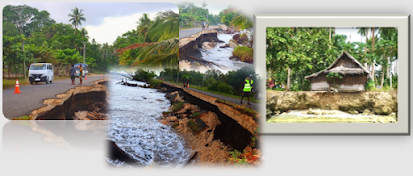SMAC: Blog Post Part 2
PG 420: Blog post 02
By Kaylyn Kiwar
A visual journey through Madang’s Changing
Coastline.
Madang province once known as the jewel in PNG’s tourism crown because of its rare beauty is now battling against the constant effect of the rising sea level. The continuous impact of the rising tide has resulted in destruction of food gardens by saltwater, affecting fresh drinking water sources, and off course the reclaiming of the land. The rising tide also resulted in social/cultural and economic impacts. For instance, in Riwo, the experience of land shortage has caused domestic violence, petty crime, alcoholism, and shortages of bush materials for building houses (Mc Kenna. et al., 2021). With that being said, let us now take you all via a visual journey discovering what the rising tides has done to some of the many coastal places in the province.
Images showing eroding sites along the family beach and Machine gun.
These images serves as proves for what the
rising sea level has done to the livelihoods due to climate change. The
challenges faced by the people due to climate change are seen and felt not only
in Madang province but in many other parts of the globe as well. This has
resulted in most island communities being exposed to high tides and flooding
putting a lot of pressures on their livelihood (Lutz, 2017). In order adopt to
the ever changing climate change effect there are several step that must be
followed and facilitated by the provincial government such as:
·
The affected communities must be relocated
meaning, the government should purchase land for them to resettle
·
Design and install sustainable water
systems that can withstand climate change effect.
·
Mangroves must be planted along the
coastal areas and third, and most importantly
·
Sea walls must be built to stop coastal
erosion
·
Images showing machine gun and a few islands
before the aftermath of the rising tides. (Images supplied online).
References:
Sumb, A.
(2020). Assessing impacts of climate change on small businesses in the Madang
lagoon area. https://www.dwu.ac.pg
Owen P,
McKenna, David, M. Mushet, Samuel, R. Kucia, C. McCulloch, H. (2021, July 28).
Limited shifts in the distribution of migratory bird breeding habitat density
in response to future changes in climate. https://esajournals.onlinelibrary.wiley.com
Lutz, W.
(2017, November 1). How population growth relates to climate change. https://www.pnas.org




Comments
Post a Comment